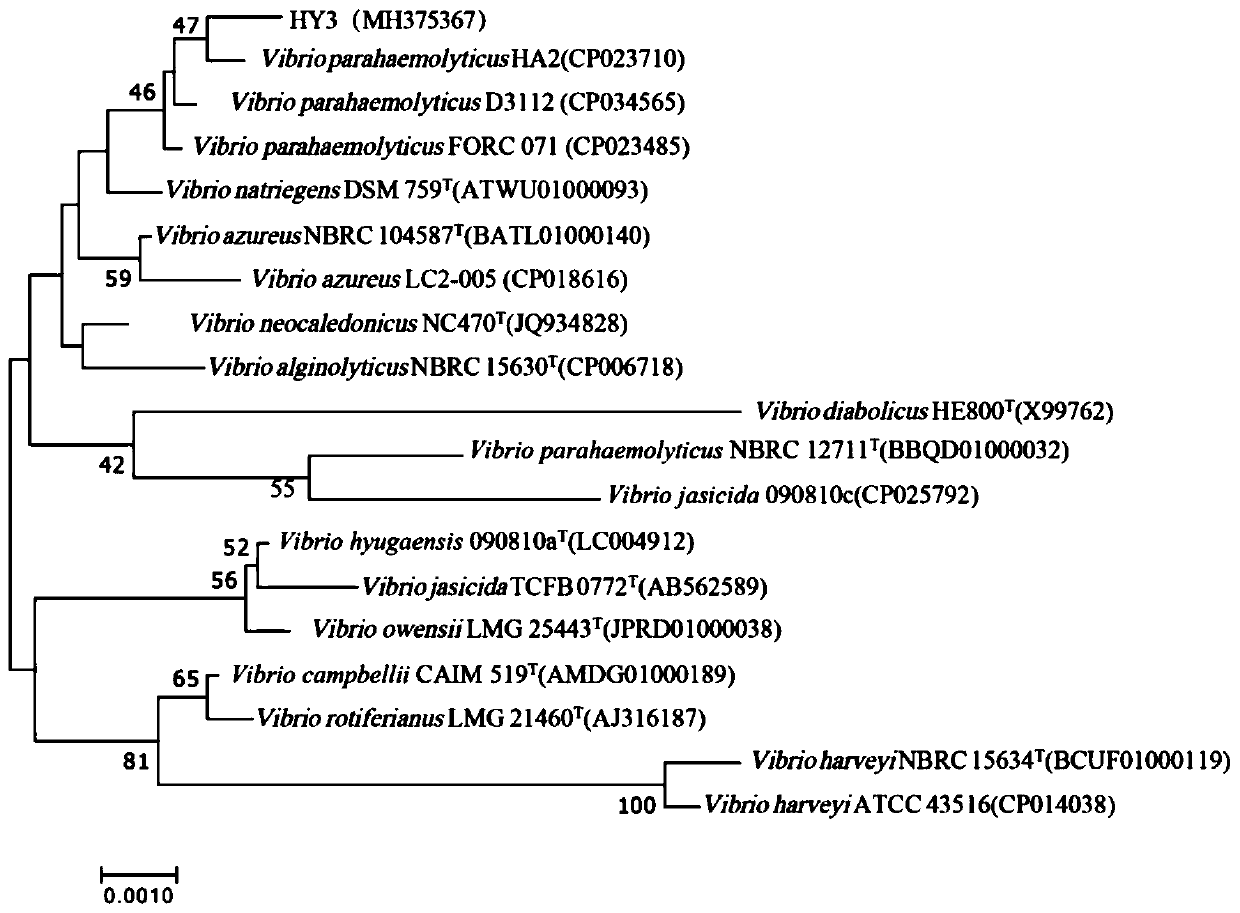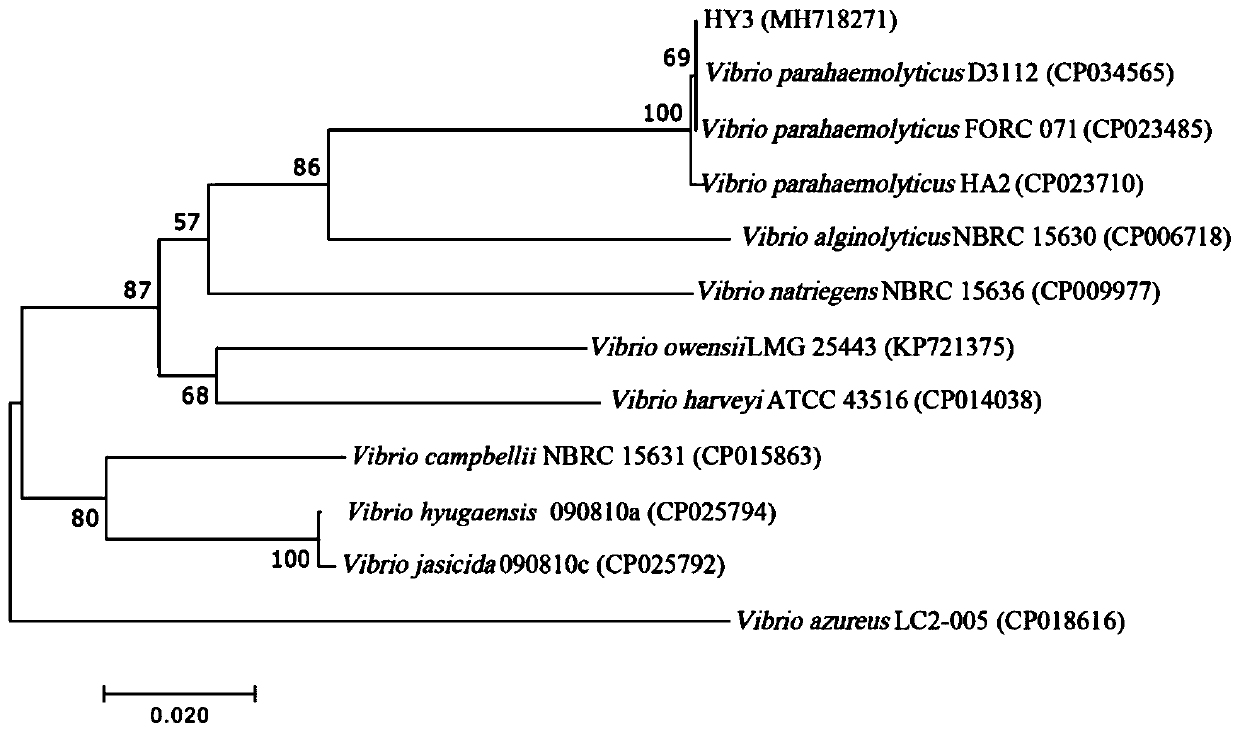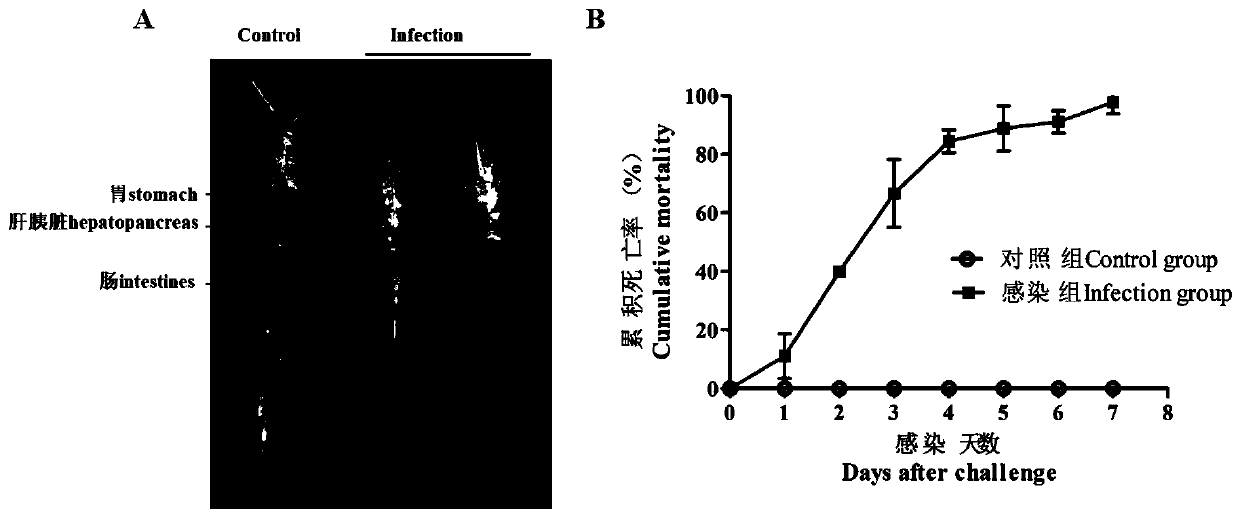Vibrio parahaemolyticus phage VP-HYP2 and application thereof
A VP-HYP2, Vibrio hemolyticus technology, applied in the direction of bacteriophage, virus/phage, application, etc., can solve problems such as the environment that does not meet the sustainable development of fishery, pollution, drug resistance problems, etc., to reduce the number of bacteria and tolerate Wide-ranging, thermally stable effects
- Summary
- Abstract
- Description
- Claims
- Application Information
AI Technical Summary
Problems solved by technology
Method used
Image
Examples
Embodiment 1
[0031] Example 1 Isolation and identification of pathogenic Vibrio parahaemolyticus HY3 caused by acute hepatopancreatic necrosis of Penaeus vannamei
[0032] The diseased Penaeus vannamei was collected from a prawn farm, and the hepatopancreas of the diseased shrimp was dipped with an inoculation loop, streaked on a TCBS plate, and cultured at 30°C for 24 hours. On the next day, randomly pick a single green colony from the TCBS plate, and streak it on an LB plate with 3% sodium chloride to purify the single colony. Streak and purify the single colony repeatedly 4 times, and freeze the purified single colony in a glycerol tube at -80°C.
[0033] Thaw frozen colonies and extract genomes. Using the genome as a PCR template, primers PirAB-2020F (5'GCACCGTAAATTTTCAGGTT 3') and PirAB-2020R (5'CGTTGCAATCTAAGACATAG 3') were used to amplify the toxic genes pirA and pirB and their partial upstream and downstream sequences. The expected size band obtained by PCR amplification was sent...
Embodiment 2
[0035] Example 2 Pathogenicity identification of Vibrio parahaemolyticus HY3
[0036] The pathogenicity of bacterial strain HY3 was tested by soaking and challenge method, specifically as follows: Healthy Penaeus vannamei (about 1g) was taken from a nearby farm, and adapted to 4- 5d. There were 15 prawns in each group, and 3 parallel groups were set up; the experimental group was soaked in 1 (OD 600 ) artificial seawater, and the control group was soaked in artificial seawater without germs for 15 minutes. The soaked prawns were taken out, and the experimental group was transferred to the pathogen concentration of 0.01 (OD 600 ) of 3L seawater, the control group was transferred to 3L of pathogen-free artificial seawater. During the test period, feed, absorb dirt, and change water every day, record the mortality of prawns, observe 7 days after infection, and count the cumulative mortality of prawns. The result is as image 3 As shown in A, compared with the non-inoculated ...
Embodiment 3
[0037]Example 3 Isolation and identification of bacteriophage VP-HYP2
[0038] With acute hepatopancreatic necrosis pathogenic Vibrio parahaemolyticus HY3 as host bacteria, a phage was isolated from Taizhou vannamei culture wastewater by double-layer agar plate method. The phage has the nucleotide of SEQ ID No.1 Sequence representation of the genome, named Vibrio parahaemolyticus phage VP-HYP2. Using the negative staining method of phosphotungstic acid, the morphology of the phage was determined under the transmission electron microscope, as shown in Figure 4 shown.
[0039] In order to make the phage plaques of the phage on the plate more obvious and clear, 5% glycerol and 0.3 μg / ml tetracycline should be added to the double-layer agar plate.
[0040] The isolated and purified Vibrio parahaemolyticus phage VP-HYP2 was sent to the China Center for Type Culture Collection for preservation on April 3, 2019, the preservation number is: CCTCC NO: M 2019227, and the preservation...
PUM
 Login to View More
Login to View More Abstract
Description
Claims
Application Information
 Login to View More
Login to View More - R&D
- Intellectual Property
- Life Sciences
- Materials
- Tech Scout
- Unparalleled Data Quality
- Higher Quality Content
- 60% Fewer Hallucinations
Browse by: Latest US Patents, China's latest patents, Technical Efficacy Thesaurus, Application Domain, Technology Topic, Popular Technical Reports.
© 2025 PatSnap. All rights reserved.Legal|Privacy policy|Modern Slavery Act Transparency Statement|Sitemap|About US| Contact US: help@patsnap.com



